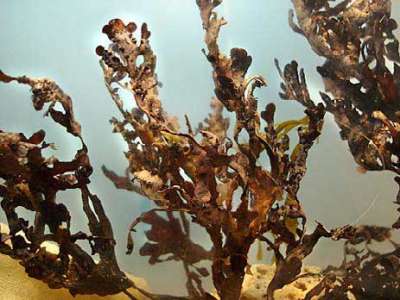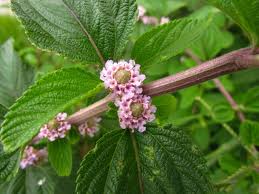



 Por Lauro M. de Souza , Guilherme L. Sassaki , Maria Teresa Villela Romanos and Eliana Barreto-Bergter
Por Lauro M. de Souza , Guilherme L. Sassaki , Maria Teresa Villela Romanos and Eliana Barreto-Bergter
Um sulfolipídio foi isolado e caracterizado da alga vermelha Osmundaria Obtusiloba, coletada no Brasil, especificamente na praia rasa em Búzios. Esta macroalga tem sido alvo de diversos estudos e substâncias bioativas de importância medicinal têm sido isoladas.
Este sulfulipídio éum glicolipídio e mostrou atividade contra os vírus do Herpes simples que são responsáveis por infecções humanas com o HSV-1 (Herpes oral ou labial) e HSV-2 (Herpes genital). Apesar de o aciclovir ser a droga de escolha, para estas infecções virais, a existência de cepas resistentes faz com que a pesquisa de novas substâncias com atividade contra este grupo de vírus seja de grande importância. O sulfolipidio além de demonstrar excelente ação antiviral apresenta baixa toxidade em culturas de células.
Structural Characterization and Anti-HSV-1 and HSV-2 Activity of Glycolipids from the Marine Algae Osmundari obtusiloba Isolated from Southeastern Brazilian Coast
Glycolipids were extracted from the red alga Osmundaria obtusiloba from Southeastern Brazilian coast. The acetone insoluble material was extracted with chloroform/methanol and the lipids, enriched in glycolipids, were fractionated on a silica gel column eluted with chloroform, acetone and then methanol. Three major orcinol-positive bands were found in the acetone and methanol fractions, being detected by thin layer chromatography. The structures of the corresponding glycolipids were elucidated by ESI-MS and 1 H/ 13 C NMR analysis, on the basis of their tandem-MS behavior and HSQC, TOCSY fingerprints. For the first time, the structure of sulfoquinovosyldiacylglycerol from the red alga Osmundaria obtusiloba was characterized. This molecule exhibited potent antiviral activity against HSV-1 and HSV-2 with EC 50 values of 42 µg/mL to HSV-1 and 12 µg/mL to HSV-2, respectively. Two other glycolipids, mono- and digalactosyldiacylglycerol, were also found in the alga, being characterized by ESI-MS/MS. The structural elucidation of algae glycolipids is a first step for a better understanding of the relation between these structures and their biological activities.
Trabalho publicado no periódico: Marine Drugs
 Por Danielle Cristina Machado Costa, Alane Beatriz Vermelho, Catia Amancio Almeida, Edilma Paraguai de Souza Dias, Sabrina Martins Lage Cedrola, Maria de Fatima Arrigoni-Blank, Arie Fitzgerald Blank, Celuta Sales Alviano e Daniela Sales Alviano
Por Danielle Cristina Machado Costa, Alane Beatriz Vermelho, Catia Amancio Almeida, Edilma Paraguai de Souza Dias, Sabrina Martins Lage Cedrola, Maria de Fatima Arrigoni-Blank, Arie Fitzgerald Blank, Celuta Sales Alviano e Daniela Sales Alviano
Os fungos dermatófitos são caracterizados por sua capacidade de penetração nos tecidos epidérmicos. Um dos mecanismos de patogenicidade conhecido é a liberação de enzimas extracelulares como as peptidases, incluindo neste grupo as queratinases.
Neste trabalho realizado por pesquisadores do Instituto de Microbiologia, UFRJ e da Universidade Federal do Sergipe, uma fração rica no óleo essencial linalol foi obtida da planta Lippia Alba, conhecida como erva cidreira. Este óleo demonstrou efeito inibidor nas peptidases e queratinases de três fungos dermatófitos: Trichophyton rubrum, Epidermophyton floccosum e Microsporum gypseum,
Estes resultados sugerem que as queratinases e outras peptidases podem ser um potencial alvo quimioterápico para o controle destas infecções fúngicas.
Inhibitory effect of linalool-rich essential oil from Lippia alba on the peptidase and keratinase activities of dermatophytes
Lippia alba (Miller) N.E. Brown is an aromatic plant known locally as ‘‘Erva-cidreira-do-campo’’ that has great importance in Brazilian folk medicine. The aim of our study was to evaluate the antidermatophytic potential of linalool-rich essential oil (EO) from L. alba and analyze the ability of this EO to inhibit peptidase and keratinase activities, which are important virulence factors in dermatophytes. The minimum inhibitory concentrations (MICs) of L. alba EO were 39, 156 and 312 mg/mL against Trichophyton rubrum, Epidermophyton floccosum and Microsporum gypseum, respectively. To evaluate the influence of L. alba EO on the proteolytic and keratinolytic activities of these dermatophytes, specific inhibitory assays were performed. The results
indicated that linalool-rich EO from L. alba inhibited the activity of proteases and keratinases secreted from dermatophytes, and this inhibition could be a possible mechanism of action against dermatophytes. Due to the effective antidermatophytic activity of L. alba EO, further experiments should be performed to explore the potential of this linalool-rich EO as an alternative antifungal therapy
EO (essential oil)
Publicado em : .J Enzyme Inhib Med Chem, Early Online: 1–6 013
Informa UK Ltd. DOI: 10.3109/14756366.2012.743537
